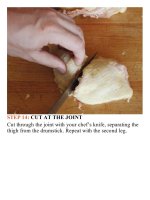The food lab better home cooking through science ( PDFDrive ) 142
Bạn đang xem bản rút gọn của tài liệu. Xem và tải ngay bản đầy đủ của tài liệu tại đây (113.93 KB, 2 trang )
Forfluffy,diner-styleomelets,thekeyistostarttheeggs
in hot butter and move them as little as possible during
cooking. Rather than shaking the pan and breaking up the
large curds, the best course of action is a move called the
lift-and-tilt:useasiliconespatulatoliftuptheedgesofthe
omelet and push them toward the center of the pan while
tiltingit,toallowtheraweggtorununderneath.Repeating
this technique means nearly all of the eggs can be set with
minimalstirring.You’llstillendupwithaslickofrawegg
acrossthetopsurface,whichiseasytotakecareof:remove
the skillet from the heat, add whatever toppings you like
(hamandcheesearemyfavorite),coveritwithalid,andlet
theresidualheatfromtheeggsgentlycookthetopthrough,
thenfolditinhalfandserve.
A tender, fancy-pants omelet—the kind I remember
watching Jacques Pépin make look so easy—can be made
by cooking the eggs fast, but it’s one of the most difficult
techniques in cooking (really). Luckily, though, it doesn’t
actually require fast cooking, and once you’ve learned the
cold-butter-cube trick you picked up with the creamy
scrambled eggs to help regulate the cooking temperature
(se ehere), you can actually make a tender French-style
omelet in much the same manner, with slow cooking and
constant stirring.The only difficult part about this style of
omeletistherolling.Thetrickistomakesurethatoneside
oftheeggdiskisthickerthantheotherbyrappingthepan
sharply against the stove as you finish cooking so that the
eggs collect on the end opposite the handle. Then let the
bottomsetslightly,andtheomeletcanberolledup,starting
atthethinneredge,beforebeingturnedoutontoaplate.
AtenderFrenchomelet.









